weight loss:
lose weight while protecting your heart – 1
Including certain foods to embrace in your diet is an important factor in the cause, and also the cure, of many ills.
By eliminating certain foods from your diet, and including others in the right amounts, and the use of nutritional supplements if recommended by a medical practitioner, you can achieve at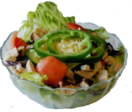 least a fifty per cent protection against heart attack while helping your weight loss efforts.
least a fifty per cent protection against heart attack while helping your weight loss efforts.
Before going on to the actual low-fat, low-cholesterol, low-calorie recipes, I sincerely hope the list of foods to embrace I have included in this article will help you in your weight loss ambitions while maintaining a healthy cholesterol and heart. Foods to avoid will be the subject of the following article.
In my article “Diet – Diet And Your Heart”, I included two menus: Menu 1 showing the fat content what the average American and some Europeans consume daily, and Menu 2 illustrating what a healthy, low-fat alternative may contain.
If you would like to a see these sample diets just click on the link Diet – Heart.
As you are probably aware, there is ever growing concern among doctors and health authorities, particularly in the western world, of the ever increasing number of people suffering from obesity and many of the diseases directly related to it, such as cardiovascular disease, cancer, and type-2 diabetes.
Including foods to embrace in your diet can help prevent some of these diseases, and may possibly reverse type-2 diabetes.
Although the survival rate of many of these diseases has increased through the use of new drugs, the number of cases increase daily and is gradually becoming an epidemic, throwing an ever increasing financial burden on health authorities and, if the present rate continues, will eventually become unsustainable.
foods to embrace: why is this epidemic happening?
Quite simply, bad diet and unhealthy eating. Junk and fast foods full of trans fats like burgers and fries are certainly not foods to embrace,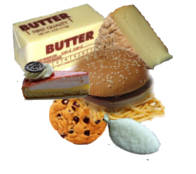 high consumption of foods full of saturated fat like butter, foods like sugar that are loaded with calories but contain no nutritional value. Foods to embrace will help you improve your diet.
high consumption of foods full of saturated fat like butter, foods like sugar that are loaded with calories but contain no nutritional value. Foods to embrace will help you improve your diet.
Is there an answer to this ever-rising tide of life-threatening obesity related diseases? Doctors, nutritionists nd health experts all agree that there is.
A change of lifestyle and a healthy calorie-controlled diet will not only help prevent these diseases but , in many cases, by including many of the foods to embrace in your diet, can reverse some of them, particularly type-2 diabetes.
I believe the recipes on the following pages can help do this, compiled by doctors and nutritionists to help weight loss, lower cholesterol and help prevent heart attacks, foods to embrace have been found to be successful over many years and provide the essential nutrients to remain healthy.
All the recipes contain less than two thousand calories, apart from one or two which contain ingredients that you can use on a “cheat day”, but only occasionally. Most of these ingredients, such as sugar, are known as empty calories and contain no nutrients, only calories, and can be dispensed with if so wished, just remember to adjust your calorie intake.
You don’t have to stick to these recipes rigidly, if you don’t like a certain food you can replace it with something else. Just make sure it is a recommended foods to embrace, or is low-fat and contains the same number of calories as the food you are replacing, that way you keep control of your calorie intake.
welcome to the low fat, low cholesterol, low calorie program
First, let’s have a look at some foods to embrace that are permitted. In the following article we will look at others that should be avoided.
soups

Bouillons and consommé’s, as they are nutritious, filling, and low in calories and fats, are ideal foods to embrace. Use fat-free vegetable soups, vegetable broths, and soups prepared with skim milk. It is imperative to remove all visible fat and grease from the soup. Here are some good ways to do this:
- Refrigerate or chill the soup first: then carefully remove the fat and grease that has caked on the top with a knife, spoon, or other suitable utensil.
- If there is not enough time for refrigerating or chilling the soup first, use bread slices by direct application to the top layer of the soup, in order to blot up or absorb the grease.
- Place some lettuce leaves on top of the heated soup. When you see the fat absorbed onto the leaf or leaves, remove them. The lettuce leaf may also impart a slight flavor to the soup, helping to lend a little zest.
- Blot up the top layer of grease by floating one or more paper towels on the surface of the soup. When it is fat-saturated, discard the towel; it is a greasy reminder of escape from unhealthy calories.
Dry soup mixes are also quite low in fat and are very enjoyable. Vegetable and vegetable-beef canned soups, however, are very low in fat content and are thus highly desirable for the low-fat, low-calorie diet. For example, half a tin (200g) of Heinz Oxtail Soup contains only 83kcal and 1g of fat, of which 0.4g is saturated.
meats
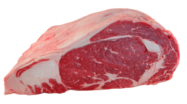
Beef, veal, and lamb are foods to embrace although naturally high in both visible and “invisible” fat and cholesterol. However, since their protein content is most desirable for energy and palatability, and because of custom, they are basic ingredients in the low-fat diet but should be used sparingly.
Much of the dietary fat allowance is contained in meat, which has its greatest amount of calories predominantly in fat. All visible fat must be carefully cut away and trimmed while raw, before cooking.
Once all visible fat has been removed all other fat can be removed by placing the meat in a slow cooker, dissolve a stock cube in boiling water and pour over the meat.
Remove the meat when cooked to your liking, let the stock cool and move to a suitable container, place in refrigerator and leave till all fat has risen to the top and solidified. You can then remove the fat with a suitable utensil and you are left with virtually fat-free stock suitable for many kinds of cooking.
If using minced meat always make sure it is labeled “extra lean” or, better still, buy lean steak, remove any fat and mince it yourself.
Remember, that among meats, pork, bacon, and ham are highest in fat and cholesterol content. They should not be eaten on a low-fat, weight loss diet other than occasionally, if permitted by your doctor or by the virtual absence of other fat-containing foods in your menus for the day.
The same is generally true of sausages, and organ foods like brains, sweetbreads, and kidneys. Liver is an exception, however. It is as a valuable nutritional source of essential vitamins and minerals, and because of the “protective” content of phospholipids that counteract the action of fat and cholesterol, it is not harmful.
fish

The following stated fat content is based on a three ounce serving, cooked.
Generally, fish is often an excellent low-fat food source and definitely one of the foods to embrace. Unlike meats, very little fats will be cooked out of the fish, so draining off fish fats in cooking is unnecessary.
Most fish are low in calories and some fish are especially low in fat, with less than 2 grams: Cod, Haddock, Hake, Pollock, Flounder and Sturgeon. Most shellfish are also low in fat and cholesterol content with less than 2 grams: Lobster, Shrimps, Clams, Scallops and Crabs are ideal examples.
Slightly higher with 2 to 5 grams are: Halibut, Pink Salmon, Perch (Ocean) and Rockfish (Pacific). Mussels and Lobsters can also be included in this category.
poultry

Chicken and Turkey are excellent foods to embrace, and good sources of animal proteins as well as being low in fat, cholesterol and calories, especially the breast. Turkey breast contains 90 calories and 1 gram of fat per 3 ounce serving as against chicken breast’s 165 calories and 5 grams of fat, of which 1 gram is saturated, per 3 ounce serving.
Always make sure lean poultry is used, the dark meat of poultry is higher in fat content than white meat. Skin and Giblets should be discarded as they are very high in fat content.
Duck and Goose are extremely high in fat and should not be included unless the fat is drained off and removed by the methods recommended in the section under meats. Also, the fat from chicken and turkey, even though much less quantitatively than that in meat, is best drained off and removed in the same manner as in the preparation and cooking of all meats.
eggs
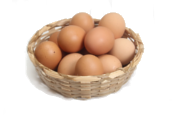
Egg whites, which are proteins, and certainly are foods to embrace, and make up more than half of a whole egg, around 66 percent, may be eaten and used for cooking as much as desired. There are 17 calories, 0.1 gram of fat and zero cholesterol in the white of 1 large egg.
The yolk of 1 large egg contains 55 calories, 4.5 grams of fat and 210mg of one of the most concentrated forms of fat available – namely cholesterol, – and therefore should be avoided, or at least eaten only occasionally.
milk and milk products

One pint or more daily of non-fat or skim milk should be taken. Fortified milk with added amounts of vitamin A and D can be taken to supply essential vitamins. Buttermilk is also a refreshing source of milk with an exceedingly low-fat, low-calorie content. 100g (around 3½ fl.oz.) contains 40 calories and 0.9 grams of fat.
As an added source of fat-free or low-fat protein, skim or fat-free milk can be fortified by adding to each glass of milk one or more tablespoons of dried, skim milk. This “fortified” milk also has a thick creamy taste and can be flavored to suit the individual taste with various flavoring agents. Yogurt made from non-fat milk can also be used for nutritious variety.
cheeses

When choosing foods to embrace, be careful with which cheese to embrace. The majority of cheeses are very high in butterfat (not to be confused with buttermilk) content and so cannot be used in the low-fat diet. There are several important exceptions, however.
- Cottage Cheese,
Contains around 100 calories and 4 grams of fat per 100 gram (3½ oz.) serving and made from dry curd and non-fat milk.
Cottage cheese must contain a minimum amount of butterfat. Make sure if purchasing cottage cheese it is not creamed, which of course, does contain fat.
When eating out, bear in mind that most restaurants use mostly creamed cottage cheese in their menus. If ordering a meal containing cheese, ask what type of cheese is being used, various brands of cottage cheese that taste like creamed cottage cheese but contain the minimum amount of butterfat are now available.
- Ricotta Cheese
Made from milk whey, and a favorite of Italian chefs, is often used. There are also other foreign brands of cheeses low or negligible in fat and calorie content, which are processed from non-fat milk or whey, such as the Geska type of Sapsago cheese (Swiss green cheese), and certain Scandinavian cheeses.
Cheese spreads or dips made from non-fat or cottage cheeses are also widely used for low-fat, low-calorie menus.
vegetables
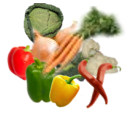
What more can be said about vegetables, the number one of foods to embrace. They’re virtually fat free and contain no cholesterol and in many cases you burn more calories digesting them than the vegetable actually contains.
Unless eaten raw, the most important part is the preparation. It is best not to soak vegetables as this can reduce the the natural flavor and nutrients.
When cooking, steaming is preferable to boiling, as this will retain more of the nutrients and natural taste than boiling since many of the essential vitamins and minerals in vegetables can be destroyed by boiling. A three-tier steamer can be purchased quite cheaply.
Don’t throw the water away you find in the steamer’s water receptacle, it contains vitamins and minerals and can be used in preparing other dishes. By adding a stock cube and a thickening agent, you have a virtually fat-free, low-calorie gravy.
fruits
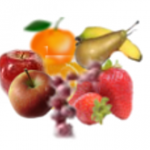
Fruits also contain virtually no fat and are entirely free of any cholesterol, making them an excellent food to embrace. One notable exception however, is the avocado, which is very high in fat content and thus should be avoided. Otherwise there is no restriction on the use of fruits, which are also certainly ideal for desserts.
salads and salad dressings
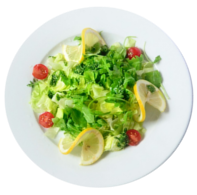
When preparing salads, another top food to embrace, make sure that salad dressings, if used, are low or fat-free, and low-calorie and all ingredients are free of added sugars and sweeteners where applicable.
Use raw vegetables almost exclusively, since the vitamin value is at peak this way, and the crispness of the vegetables is most appetizing. Unless specifically added, they’re fat and cholesterol free.
Fresh fruit salads are in the same category and are particularly refreshing and nutritious. When fresh fruits are not in season, use dried, canned, or frozen fruits. If using canned fruits make sure they are in natural juice and not syrup.
Various combinations of fruit can be used with vegetables, cottage cheese, or gelatin recipes. Gelatin salads are special favorites to many, especially when made with fruit juices instead of water. Aspic salads are excellent when prepared with vegetables or vegetable juices. If cottage cheese is added to gelatin and aspic salads, more protein and “body” results.
Salad dressings low in fat content and calories are readily available from most of the major food manufacturers. These do contain a relatively small degree of fat, however, so it is best to prepare your own fat-free dressings whenever possible, such as the ones described in low-fat, low-calorie Menu 1.
Mineral oils are not recommended for use in salads as they can interfere with absorption of vitamin A in the food. If used they should only be used occasionally.
If allowance is made for the caloric content of the vegetable oils, most contain 120 calories per tablespoon, they are ideal and a valuable addition as a dressing in salads.
Vegetable oils are exceptions to other fatty foods in that they contain large amounts of unsaturated fatty acids. These fatty acids are very effective in reducing the fats and the cholesterol present in the blood stream. They are thus “protective” against the harmful effects upon the arteries of other fats, such as contained in butter, milk, eggs, and cream.
The recommended daily intake of dietary fat is: saturated fat, 20 grams for women, 30 grams for men; unsaturated fat, 50 grams for women, 60 grams for men.
Below is a list that are excellent for use in dressings and salads. Always buy unrefined oils, such as cold pressed or expeller pressed as they are full of minerals, enzymes, and other essential compounds.
If you want to cook with them as well as using them in salads and dressings, buy the refined version. Although they lose a lot of their natural ingredients in the refining process they’re better for cooking with, as the unrefined equivalent doesn’t stand up well to heat.
Some oils don’t have a very long shelf life and are best purchased in small quantities that you will use within three months, but always read the use by date and storage instructions.
Purchase oil in dark glass bottles or tins whenever possible and store in a cool cupboard or pantry away from light. Some people store oil in a refrigerator and may find the oil has gone cloudy, but this shouldn’t affect the quality of the oil, although it is always advisable to bring it back to room temperature before using.
Measurements are based on one tablespoon (14 grams) which, in most cases, contains 120 calories. Where grams are stated I have rounded up or rounded down to the nearest whole point. 1 to 4 is rounded down, 5 to 9 is rounded up. For example 1.214 would become 1.21 and 1.219 would become 1.22.
- Rapeseed (Canola) Oil
Total fat 13.6 grams, with less than 1 gram, (0.97), about 7 percent, being saturated, it is considered by many to be the healthiest of all the oils.
It is also well balanced in unsaturated fats: containing 8.1 grams, (59 percent), of monounsaturated and 4 grams, (29 percent), of polyunsaturated, as well as being rich in omega-6 and omega-3 fatty acids.
- Hemp Oil
Another good choice for use in salads and dressings as it contains no sodium, sugar, protein carbohydrates or, most importantly, no cholesterol, although it is not suitable for cooking due to its low smoke temperature.
One tablespoon of hemp oil contains approximately 120 calories and 14 grams of fat: 1 gram, (9 percent), of saturated fat; 10 grams, (80 percent), of polyunsaturated fat; and 3 grams, (11 percent), of monounsaturated fat. This represents around 22 percent of the daily amounts listed above.
- Extra Virgin Olive Oil
High in antioxidants called polyphenols that are believed to help maintain a healthy heart, and a good source of monounsaturated fats, extra virgin olive oil contains in total 13.5 grams of fat.
Although it is slightly higher in saturated fat than some oils: 1.9 grams, (14 percent), it is one of the most popular. There are 9.9 grams, (78 percent), of monounsaturated fat and 1.42 grams, (8 percent), of polyunsaturated fat.
- Walnut Oil
You will probably find this oil more expensive than the average oil as it tends to be classed as a specialty oil. Along with its rich, nutty flavor it is also a good source of omega-3.
Although not to everyone’s taste in some dishes, drizzled over a fresh salad, or added to a low-fat salad dressing, it is delicious.Total fat is 13.6 grams, with 1.21 grams, (9 percent), being saturated fat; 8.46 grams, (67 percent), polyunsaturated fat; and just over 3 grams, (24 percent), monounsaturated fat.
- Grapeseed Oil
A mild flavored multipurpose oil, although the flavor may vary depending on where the grapes were grown.
Due to its high smoke temperature it’s excellent for roasting and sautéing, as well as in salad dressings.Again, 13.6 grams of fat in total, with 1.21 grams, (10 percent), being saturated fat; 9.37 grams, (73 percent), polyunsaturated fat; and 2.13 grams, (17 percent), monounsaturated fat.
- Virgin Coconut Oil
Long regarded as unhealthy due its high saturated fat content, there are 12 grams of saturated fat and minimal amounts of unsaturated fats in 14 grams of coconut oil, although there are slightly less calories (117).
Research over a number of years has shown that this is no longer the case and there are now many health benefits to be gained from coconut oil, particularly when used in cooking as it doesn’t, unlike some other oils, oxidize at high temperatures, thereby reducing the number of free radicals created.
There are many other benefits to be gained. Researchers found that consuming two tablespoons of coconut oil daily increased the metabolism speed and help boost the body’s immune system as well as weight loss.
The medium-chain saturated fatty acids (MCFA’s), found in coconut oil, are quickly converted by the liver into energy instead of being stored as fat, which helps reduce excess abdominal fat.
It has also been found that MCFA’s protect against resistance to insulin, instead increasing insulin sensitivity, which helps reduce the risk of contracting type-2 diabetes. These, and many other health benefits, can be found in coconut oil.
cereals

These are nutritious, energy producing, and virtually fat free foods to embrace, and whether cooked or dry, cereals are excellent carbohydrate foods if served with non-fat milk.
Although some commercially produced cereals like Kellogs Cornflakes, Weetabix, Kellogs All-Bran and Alpen Muesli are nutritious, and low fat if skim milk is used, I prefer home made using unrefined cereals, many of which you can purchase from health food stores.
Rather than use sugar, the taste is enormously enhanced by the addition of stewed or fresh fruits such as bananas, prunes, peaches, pears, apricots, berries, dates and figs, raisins, or baked apple.
Whole wheat and whole grain cereals are also an important source of vitamin B complex and protein in the low-fat diet. Their cooking can be done with skim milk if it is not boiled or burned. The addition of one-to-four tablespoons of wheat germ to the cereal is an excellent nutritional supplement and is an ideal daily food when added to the cereal.
For those who work and feel best beginning the day with a substantial breakfast, the inclusion of the above cereal, skim milk, fruit, and wheat germ “combo” is excellent for energy, proteins, vitamins, and minerals.
breads
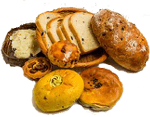
Both white and whole wheat breads contain only a negligible amount of fat (approximately five per cent by weight) a minority quantity of protein (about twenty per cent) the rest is carbohydrate and may not be suitable for somebody on a low carbohydrate diet.
While white bread contains slightly lower calories (66 per 1 regular slice), whole wheat bread (69 per 1 regular slice) is the healthiest, most nutritious form of the “staff of life”. Many bakeries customarily incorporate some lard, butter, or egg yolk in most yeast loaf bread, sweet rolls, rolls, muffins, buns, and coffee cake and are best avoided.
There are various enriched breads on the market that are also nutritious as far as vitamin B complex is concerned, and these often match one hundred per cent whole wheat, rye, or pumpernickel breads in this regard.
desserts

Fat-free sweets are great energy producers as well as comforting for that “sweet-tooth”. Excellent, but high in calories because of sugar content, are jams, jellies, marmalade, honey, molasses, maple syrup, and if desired should be used sparingly. Hard candies and candies without nuts, creams, or chocolate are also fat-free.
beverages

A wide choice of fat-free drinks are available to all, such as tea, coffee, coffee substitutes, skim milk, fat-free milk. These should remain unsweetened, but use sugar sparingly if required, as one teaspoon of sugar contains 15-16 calories. Artificial sweeteners are not recommended.
Non-fat milk cocoa and skim milk powder shakes, with natural flavoring added if desired, can be taken in between meals or at bedtime. Fresh fruit and vegetable juices are also appealing and nutritious, as is fat-free yogurt. But don’t forget the healthiest of them all: Water!
I hope this has given you some insight into the foods to embrace and oils that will aid weight loss, a healthy heart, and help maintain a healthy lifestyle. In the second part we will look at foods to avoid whenever possible.

2 Comments
Leave a reply →